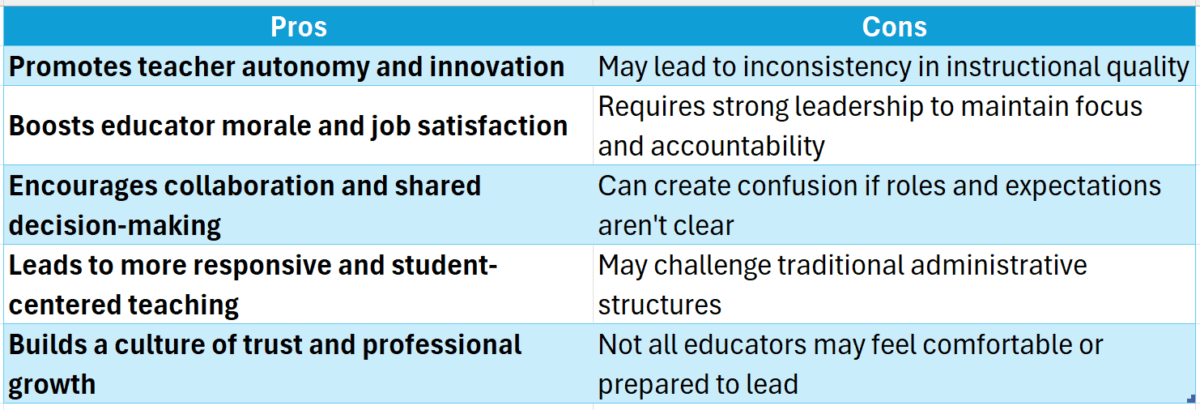
Have you ever wondered how teachers can become even better at their jobs? Instructional empowerment is a game-changer in education. It allows teachers to take charge of their teaching methods, making learning more effective and engaging for students. This transformation matters because it helps create a classroom where every student can thrive, especially in a world that values differentiated education.
What is Instructional Empowerment?
Instructional empowerment means giving teachers the tools and confidence to design their lessons. This approach encourages creativity and innovation in teaching. When teachers feel empowered, they can:
- Tailor lessons to meet diverse student needs.
- Use technology and resources effectively.
- Foster a positive learning environment.
Benefits of Instructional Empowerment
When teachers embrace instructional empowerment, the benefits are clear:
- Improved Student Engagement: Students are more interested when lessons are tailored to their interests.
- Better Learning Outcomes: Differentiated education leads to higher achievement for all students.
- Professional Growth: Teachers develop new skills and confidence, enhancing their careers.
In conclusion, instructional empowerment is not just a buzzword; it’s a vital shift in how we approach teaching. By embracing this new paradigm, educators can transform their practices and create a more inclusive and effective learning environment.
Unlock your potential with online degrees—Learn more!
How Instructional Empowerment Enhances Teacher Autonomy

Instructional empowerment is a game-changer in the world of education. It allows teachers to take charge of their teaching methods, leading to more effective and personalized learning experiences. When teachers feel empowered, they can adapt their strategies to meet the diverse needs of their students, making learning more engaging and relevant.
Benefits of Instructional Empowerment
- Increased Creativity: Teachers can explore new ideas and approaches, fostering a more dynamic classroom environment.
- Personalized Learning: With instructional empowerment, educators can implement differentiated education strategies that cater to individual student needs.
- Professional Growth: Empowered teachers often pursue further education, such as an EDD in instructional design online, enhancing their skills and knowledge.
When teachers have the freedom to innovate, they create a classroom atmosphere that encourages student participation and curiosity. This not only boosts student engagement but also helps teachers feel more fulfilled in their roles. Ultimately, instructional empowerment transforms teaching practices by fostering a culture of collaboration and continuous improvement.
The Role of Collaborative Learning in Instructional Empowerment
Instructional empowerment is a game-changer in the world of education. It allows teachers to take charge of their teaching methods, leading to more effective and engaging classrooms. When educators feel empowered, they can adapt their strategies to meet the diverse needs of their students, making learning more accessible and enjoyable for everyone.
Benefits of Collaborative Learning
- Fosters Teamwork: Students learn to work together, sharing ideas and perspectives.
- Encourages Differentiated Education: Teachers can tailor lessons to fit various learning styles, ensuring no one is left behind.
- Builds Confidence: When students collaborate, they gain confidence in their abilities and contributions.
By integrating collaborative learning into instructional empowerment, teachers can create a dynamic classroom environment. This approach not only enhances student engagement but also promotes critical thinking skills. As educators explore EDD instructional design online, they can discover innovative ways to implement these strategies effectively. In conclusion, the transformation of teaching practices through instructional empowerment is significant. By embracing collaborative learning, teachers can create a more inclusive and effective educational experience. This not only benefits students but also enriches the teaching profession, making it more fulfilling and impactful.
Can Instructional Empowerment Improve Student Engagement?
Instructional empowerment is a game-changer in education. It allows teachers to take charge of their teaching methods, leading to more engaging and effective classrooms. When educators feel empowered, they can adapt their lessons to meet the diverse needs of their students, making learning more enjoyable and impactful.
Understanding Instructional Empowerment
Instructional empowerment means giving teachers the tools and freedom to innovate. This approach encourages differentiated education, where lessons are tailored to fit various learning styles. As a result, students are more likely to participate and stay interested in their lessons.
Benefits of Instructional Empowerment
- Increased Creativity: Teachers can experiment with new teaching strategies.
- Better Student Relationships: Empowered teachers often connect more with their students.
- Enhanced Learning Outcomes: When students are engaged, they learn better and retain information longer.
- Support for Online Learning: Programs like EDD instructional design online help teachers develop skills for digital classrooms.
In conclusion, instructional empowerment not only transforms teaching practices but also significantly boosts student engagement. When teachers feel supported and inspired, their enthusiasm translates into a more dynamic and interactive learning environment. This ultimately leads to better educational experiences for everyone involved.
Transforming Classroom Dynamics Through Instructional Empowerment
Imagine a classroom where every student feels confident and engaged. This is the magic of instructional empowerment! It transforms teaching practices by giving educators the tools to meet diverse learning needs. When teachers embrace this approach, they can create a more inclusive environment that fosters growth and curiosity.
What is Instructional Empowerment?
Instructional empowerment means equipping teachers with the skills and resources to adapt their teaching styles. This is especially important in differentiated education, where students have unique learning preferences. By understanding these differences, teachers can tailor their lessons, making learning more effective and enjoyable.
Benefits of Instructional Empowerment
- Enhanced Student Engagement: When teachers feel empowered, they inspire students to take charge of their learning.
- Improved Learning Outcomes: Tailored instruction leads to better understanding and retention of information.
- Collaboration Opportunities: Empowered teachers often share strategies, creating a supportive community.
In the age of online education, such as EDD instructional design online programs, teachers can access innovative strategies to further enhance their skills. This not only benefits them but also transforms the entire classroom dynamic, making learning a collaborative adventure for everyone involved!
Unlock your potential with online degrees—Learn more!
Real-World Examples of Instructional Empowerment in Action
Instructional empowerment is a game-changer in education. It allows teachers to take charge of their teaching methods, leading to more engaging and effective learning experiences. By embracing this approach, educators can transform their classrooms into dynamic environments that cater to diverse student needs.
Personalized Learning Paths
- Differentiated Education: One school implemented personalized learning paths for students. Teachers used data to identify each student’s strengths and weaknesses, allowing them to tailor lessons. This approach not only boosted student engagement but also improved overall performance.
Collaborative Teaching Strategies
- Team Teaching: In another example, two teachers collaborated to create a cross-curricular project. By combining science and art, they empowered students to explore concepts creatively. This not only made learning fun but also helped students see the real-world applications of their studies.
Online Learning Innovations
- EDD Instructional Design Online: With the rise of online education, many educators are using EDD instructional design online to enhance their teaching. They create interactive modules that allow students to learn at their own pace, fostering independence and deeper understanding. This flexibility is crucial in today’s fast-paced world.
How ‘CollegeAndTuition.com’ Supports Educators in Their Empowerment Journey
Instructional empowerment is a game-changer in education. It allows teachers to take charge of their teaching methods, leading to more effective learning experiences. When educators feel empowered, they can adapt their strategies to meet the diverse needs of their students, making learning more engaging and personalized.
Personalized Learning Opportunities
- Differentiated Education: At ‘CollegeAndTuition.com’, we believe in meeting each student where they are. Our resources help teachers design lessons that cater to various learning styles and abilities.
- Evolving Teaching Practices: With our support, educators can explore new instructional techniques that enhance their teaching effectiveness and student engagement.
Professional Development Resources
- EDD Instructional Design Online: Our online courses provide educators with the tools they need to implement instructional empowerment in their classrooms. These courses are designed to fit into busy schedules while offering valuable insights into modern teaching practices.
- Community Support: Joining our platform connects educators with a community of like-minded professionals who share ideas and strategies for success. This collaborative environment fosters growth and innovation in teaching.
By embracing instructional empowerment, educators can transform their classrooms into vibrant learning spaces. With the right tools and support from ‘CollegeAndTuition.com’, teachers can confidently navigate the challenges of differentiated education, ensuring every student has the opportunity to thrive.
Future Trends: The Evolution of Instructional Empowerment in Teaching
Imagine a classroom where every student feels confident and engaged. That’s the magic of instructional empowerment! This approach transforms teaching practices by allowing educators to tailor their methods to meet diverse learning needs. As we explore this evolution, we see how it shapes the future of education.
The Power of Differentiated Education
Instructional empowerment encourages differentiated education. This means teachers can adapt lessons to fit each student’s unique style. For example, some students might thrive with hands-on activities, while others prefer reading or digital resources. By embracing these differences, teachers create a more inclusive environment.
Online Learning and EDD Instructional Design
With the rise of online learning, especially through programs like EDD instructional design online, instructional empowerment is more accessible than ever. Educators can now design courses that cater to various learning preferences, making education more engaging. This flexibility not only benefits students but also empowers teachers to innovate and grow in their practices.
In conclusion, as instructional empowerment continues to evolve, it promises to create classrooms where every student can shine. By embracing differentiated education and leveraging online resources, teachers can transform their practices and inspire the next generation of learners.
Unlock your potential with online degrees—Learn more!
FAQs
1. What is instructional empowerment?
Instructional empowerment is a teaching approach focused on giving educators and students the tools, strategies, and autonomy to drive meaningful learning and growth in the classroom.
2. How does instructional empowerment benefit teachers?
It provides teachers with proven frameworks, classroom strategies, and coaching support to improve student engagement, learning outcomes, and instructional effectiveness.
3. What is the difference between instructional empowerment and traditional teaching methods?
Traditional methods often emphasize compliance and content delivery, while instructional empowerment focuses on student-centered learning, critical thinking, and teacher autonomy.
4. Is instructional empowerment research-based?
Yes, it draws on decades of educational research in areas like cognitive science, equity in education, and student-centered learning practices.
5. Who implements instructional empowerment programs?
School districts, instructional coaches, administrators, and teachers can implement these programs with support from organizations that specialize in instructional transformation.
6. What strategies are commonly used in instructional empowerment?
Common strategies include active learning, formative assessment, student self-monitoring, culturally responsive teaching, and real-time feedback loops.





